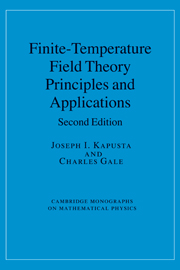Book contents
- Frontmatter
- Contents
- Preface
- 1 Review of quantum statistical mechanics
- 2 Functional integral representation of the partition function
- 3 Interactions and diagrammatic techniques
- 4 Renormalization
- 5 Quantum electrodynamics
- 6 Linear response theory
- 7 Spontaneous symmetry breaking and restoration
- 8 Quantum chromodynamics
- 9 Resummation and hard thermal loops
- 10 Lattice gauge theory
- 11 Dense nuclear matter
- 12 Hot hadronic matter
- 13 Nucleation theory
- 14 Heavy ion collisions
- 15 Weak interactions
- 16 Astrophysics and cosmology
- Conclusion
- Appendix
- Index
12 - Hot hadronic matter
Published online by Cambridge University Press: 04 November 2009
- Frontmatter
- Contents
- Preface
- 1 Review of quantum statistical mechanics
- 2 Functional integral representation of the partition function
- 3 Interactions and diagrammatic techniques
- 4 Renormalization
- 5 Quantum electrodynamics
- 6 Linear response theory
- 7 Spontaneous symmetry breaking and restoration
- 8 Quantum chromodynamics
- 9 Resummation and hard thermal loops
- 10 Lattice gauge theory
- 11 Dense nuclear matter
- 12 Hot hadronic matter
- 13 Nucleation theory
- 14 Heavy ion collisions
- 15 Weak interactions
- 16 Astrophysics and cosmology
- Conclusion
- Appendix
- Index
Summary
We know that QCD is the formal theory of the strong interaction. In principle, its solution should yield the complete particle spectrum as well as produce the interaction terms that regulate how different particle species interact. However, this complete solution is at present impossible, partly owing to the fact that at the scale of the lighter degrees of freedom QCD is strongly coupled. To describe the interaction and the properties of hot and dense hadronic ensembles, one must turn to effective approaches. They vary in character and in philosophy. In this chapter, we shall discuss some of these techniques. They comprise effective Lagrangian theories, which aim to represent in a simple way the dynamical content of a theory in the low-energy limit. The heavier fields are integrated out, leaving a set of constants to be determined by experiment. In the specific case of QCD, the choice of low-energy effective Lagrangian is dictated by general symmetry principles, and chiral symmetry will be seen to play a special role.
A remarkably successful effective Lagrangian approach to low-energy QCD is that of chiral perturbation theory. We consider this first and study its finite-temperature behavior. Next, we will use the fact that the spectrum of strongly interacting particles is quite well known experimentally to outline a technique that enables an evaluation of in-medium self-energies directly from experimental data input. The rest of the chapter will be devoted to a discussion of the Weinberg sum rules at nonzero temperatures and to investigations of the characteristics of the linear and nonlinear σ models.
- Type
- Chapter
- Information
- Finite-Temperature Field TheoryPrinciples and Applications, pp. 240 - 288Publisher: Cambridge University PressPrint publication year: 2006



